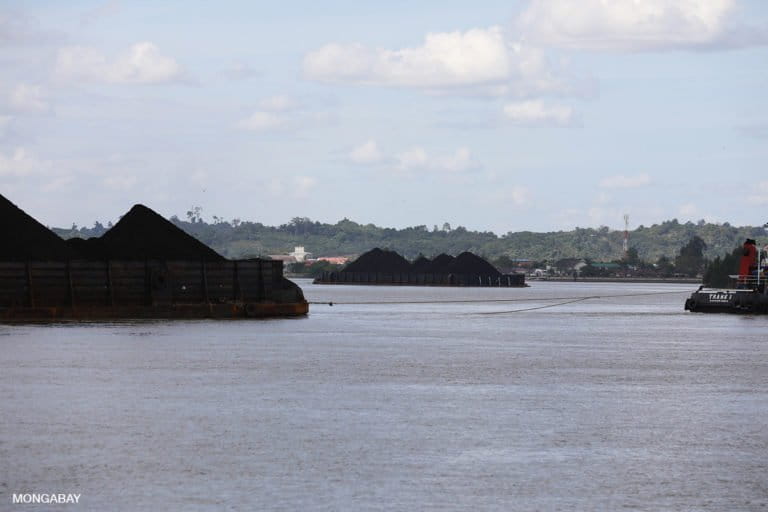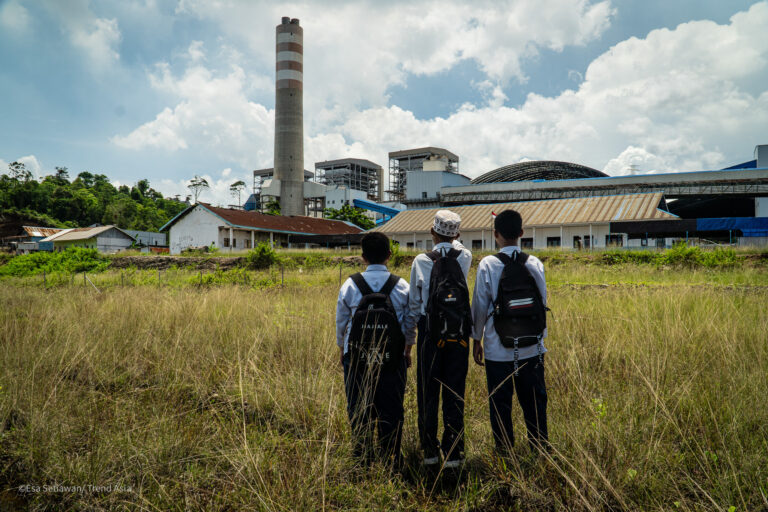- A new report suggests that publicly funded multilateral development banks may be indirectly financing coal projects they own, such as the Ob Island nickel smelter, which received indirect financing from the International Finance Corporation (IFC).
- Captive coal plants are not included in the pledge to stop financing new coal plants by 2023. Indonesia’s government has said that loopholes allow new coal plants to be developed as long as they are built to power industries that add value to natural resources, such as captive coal plants that serve nickel and aluminum smelters.
- This means that multilateral banks can continue to finance company-owned coal-fired power plants that contribute to EVs and renewable energy supply chains without technically breaking a country’s climate commitments.
JAKARTA — Publicly funded multilateral development banks (MDBs) such as the World Bank could fund a wave of “monopoly” coal expansion in climate-vulnerable countries, accelerating global warming.
A new report has revealed that the World Bank’s private sector arm, the International Finance Corporation (IFC), indirectly financed at least one coal project on Indonesia’s Ob island through its financial intermediary client, Bank Hana Indonesia.
IFC invested $5 million to help Korea Hana Bank set up its Indonesian subsidiary in 2007. Then, in 2019, IFC invested a further $15.36 million to increase its shareholding in Indonesia Hana Bank.
In April 2022, Hana Bank Indonesia, together with other banks such as DBS Singapore and UOB Singapore, provided long-term loans totalling $530 million to PT Halmahera Jaya Ferronicel (HJF), a subsidiary of nickel producer Harita Nickel.
The loan was used to repay the company’s debt and to construct the first phase of HJF’s nickel smelter on Ob Island, which will be powered by six captive coal-fired units of 150 MW each.
This means that IFC has indirectly funded the smelter and its company-owned coal unit, according to a recent report by Recourse, Trends Asia and Inclusive Development International.
Nickel processing in Indonesia is often done with captive coal, a key component of batteries that power electric vehicles and energy storage systems. Captive coal is also often a feedstock for other metals such as steel and aluminum, which are key sources for renewable energy projects such as solar and wind power.
An IFC spokesman said if Hana Bank Indonesia had financed the smelter, it did not automatically mean it had also financed its own coal-fired power plant.
However, as the financing arrangement for the captive coal unit is not clearly defined, the developer may use the funds allocated for the smelter to finance the coal unit or may finance the coal unit from its own account while receiving funds for financing the smelter, considering that the funds are ultimately interchangeable.
So, the end result is the same – indirect financing from IFC will enable the developer to build the smelter and its captive coal unit, the report said.
“Currently, the World Bank Group is blind to the risks that domestic coal poses to people and the planet,” said Daniel Willis, financial campaigner for Recourse. “It would be a great irony if, in the name of financing the production of materials needed for the renewable energy transition, multilateral development banks were also financing the rapid expansion of climate-destructive domestic coal.”
Another IFC financial intermediary, OCBC NISP (the Indonesian subsidiary of Singapore-based commercial bank OCBC), is also financing another coal-fired nickel smelter project on Ob island in the South Halmahera region of North Maluku.
In 2020, IFC made a $200 million debt investment in OCBC NISP’s sustainability bond program, which includes green and gender bonds, to lend to climate projects and women-owned small and medium-sized enterprises, known as SMEs.
IFC said high-risk projects such as smelters would not be eligible for IFC financing.
But even if IFC’s own funds do not specifically support the nickel smelter project, the investment will free up capital for OCBC NISP to invest in other parts of its climate change portfolio, including the smelter, the report noted.
“Ultimately, IFC’s investment in OCBC NISP represents a missed opportunity,” the report states. “While there may be some climate benefits from the sub-projects supported by this investment, IFC should use its leverage at the point of investment to urge financial intermediaries to stop financing coal in all its forms. If IFC is unable to do this, it should commit to stop financing financial intermediaries involved in the expansion of coal, including captive coal.”

loophole
Like many other publicly funded MBDs, the World Bank has committed to halting funding for coal-fired power projects and shifting its resources to renewable energy to tackle climate change.
So how will IFC fund Indonesia’s coal projects?
This is because there is a loophole in the company’s pledge to stop financing new coal-fired power plants by 2023, according to the report, which explicitly states that the pledge does not include company-owned coal plants.
This means that IFC clients are free to support their own coal-fired power companies.
“That is why DFI policies seeking to end support for coal should explicitly exclude financing for company-owned coal-fired power plants or subprojects that rely on company-owned coal,” the report said.
The World Bank and other MDBs, including the Asian Development Bank (ADB) and the Asian Infrastructure Investment Bank (AIIB), also announced a joint plan in June 2023 to end financing for coal mining and coal-fired power plants to align with the Paris Agreement’s climate goal of limiting global temperature rise to 1.5°C (2.7°F).
However, these joint commitments also do not cover captive industrial coal units.
Elsewhere in the same document, the MDB said projects related to “manufacturing components for renewable energy” will always be eligible for MDB financing because they are deemed “universally aligned.”
These loopholes allow MDBs such as the World Bank to continue financing company-owned coal-fired power plants that contribute to the EV and renewable energy supply chains without technically violating climate change policies.
And that could mean disaster for global efforts to phase out coal, the biggest contributor to global warming, said David Predo, executive director of Inclusive Development International.
“Whatever its purpose, off-grid power is still coal-fired and the human and environmental costs are the same,” he said. “Neither the plants nor the projects that rely on them can be called green and should not be supported, directly or indirectly, by the World Bank or any other sustainable development agency.”
The report therefore calls on financial institutions like the World Bank to develop strong, robust policies to eliminate support for all coal-fired power, including their own coal plants.
“Without strong policies from these MDBs, there remains a significant risk that public funds will support a new wave of so-called ‘green’ captive coal investment,” the report said.
Otherwise, countries that still rely heavily on coal, such as Indonesia, will continue to rely on coal, the report said.

Indonesia
In recent years, Indonesia has been building a wave of new captive coal-fired power plants aimed at supporting industrial processes such as metals smelting and cement production without feeding electricity into the power grid.
Currently, company-owned coal plants account for about half of Indonesia’s total coal-fired power capacity.
Plus, there are many more projects in the works.
Indonesia is set to more than double its captive coal-fired generating capacity from 14.2 gigawatts to 32.7 gigawatts if current expansion plans by public and private developers go ahead, according to data from Global Energy Monitor.
This is despite the government committing to limit emissions from coal-fired power generation and reducing grid-connected coal capacity to 24.6GW in 2045 from a planned 40.6GW in 2030. Indonesia aims to completely phase coal out of its power grid by 2050.
However, the report said that increases in self-generation capacity will fully offset the decline in grid-connected coal-fired power capacity, with Indonesia’s overall coal-fired power capacity expected to increase until 2045.
Most of these planned captive coal units will support Indonesia’s rapidly growing nickel processing industry, which has the world’s largest nickel reserves and is the world’s largest nickel producer.
The government is banking on nickel reserves to capitalize on growing demand for EVs and aims to become an EV powerhouse.
Industrial parks like Ob Island already account for more than 15% of Indonesia’s coal use, which increased by 33% in just one year from 2021 to 2022.
Although the government announced a moratorium on the construction of new coal-fired power plants in 2021, companies have received permission from the government to build new captive coal-fired power plants.
That’s because regulations issued by President Joko Widodo in 2022 provide that the coal moratorium has a loophole that allows the development of new coal-fired power plants as long as they are built to power industries that add value to natural resources. That means captive coal-fired power plants built to serve nickel and aluminum smelters are allowed to be developed.
Additionally, Indonesia’s financial regulator, OJK, is classifying its coal projects that contribute to the low-carbon transition, such as those that provide power for EVs and the processing of minerals used in renewable energy, as “green” projects in its new sustainable investment taxonomy.
The move sends a signal to local commercial banks, which are often tolerant of coal policies, that OJK supports financing for both owned coal projects and projects that rely on owned coal, the report said. It also suggests that owned coal could be considered an appropriate use of funds earmarked for climate spending, such as climate finance and green bond projects, the report added.
According to Nobita Indori, an energy activist at Trends Asia, there should be no room for coal in Indonesia’s energy transition if it is to meet the climate goals of the Paris Agreement.
“An energy transition process that still leaves room for coal is neither fair nor just,” she said. “Increased coal use will only jeopardize the achievement of the Paris Agreement goals and exacerbate the damage and suffering to the environment and people around Indonesia.”
Banner image: A captive coal-fired power plant behind the school on Obi Island. Image courtesy of Esa Setiawan/Trend Asia.
Feedback: Use this form to send a message to the author of this post. If you would like to post a public comment, you can do so at the bottom of the page.


